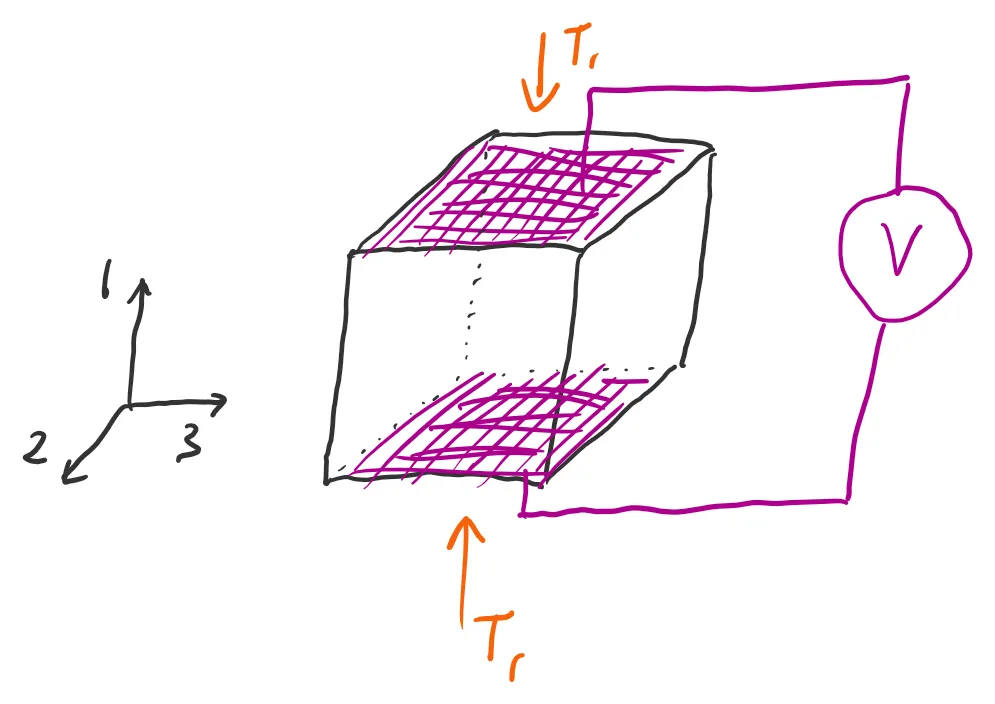EE3901/EE5901 Sensor Technologies Week 12 Tutorial
The first 3 questions require material data from PI Ceramic GmbH.
All materials in that datasheet have tetragonal crystal symmetry, i.e.
Question 1
The material PIC153 from PI Ceramic GmbH is being used in a force sensing application,
as shown in Figure Q1. The material is poled along axis 3. The device is a 1 cm
The geometry of the device for Questions 1 and 2.
Zoom:(a) Calculate the voltage
(b) Calculate the voltage
(c) Calculate the voltage
(d) Determine the relationship between the stresses
Answer
The electric displacement
The measured voltage is determined by
Substituting
The device is 1 cm thick, so
Substituting the material properties,
Hence we can evaluate each scenario by substituting the given stresses.
(a)
(b)
(c)
(d) Substituting
Hence any values of
Question 2
Ceramic piezoelectric materials lose their inherent polarisation if they are heated above a temperature known as the Curie temperature. Suppose that the sensor in Question 1 needs to operate at 300 °C. Choose the material from the datasheet that will provide the highest sensitivity to strains along axis 3 (as per Figure Q1) but can tolerate these higher temperatures.
Answer
Sensitivity to strains along axis 3 are determined by
Question 3
A piezoelectric shear actuator is built using PIC151, as
shown in Figure Q3. The height of an individual layer (when it is perfectly vertical) is 0.8 mm. The applied voltage is
(a) Consider initially a device made from a single layer (of height 0.8 mm). Use the piezoelectric actuator equation
to calculate the strain
(b) Now consider the multi-layer structure shown in Figure Q3 (b). Let
Hint: Engineering shear strain has units of radians, shown in the figure by the angle
(c) How many stacked actuator layers would be required to achieve a working range of 2 μm given an applied voltage range of 0 to 100 V?
A piezoelectric shear actuator. (a) A single element with the shear greatly exaggerated for clarity. Applying a voltage in direction 1 causes a bending of the tip. (b) A complete actuator has multiple layers with each subsequent layer having an opposite polarisation direction and opposite voltage polarity. The overall movement distance is
Answer
(a) The electric field is
Using zero stress (
The only nonzero strain is the shear strain
Substituting the actual numbers,
(b) Since the shear strain is small, we can approximate the geometry to be a triangle. Hence
Note that shear strains are so small that
(c) Each actuator provides 61 nm of travel distance, so to achieve 2 μm we need
Question 4
A sample of quartz has a piezoelectric coefficient matrix of the form
Also, the material has a relative permittivity of 4.5.
(a) Sketch a 3D cube and draw the axes 1, 2, and 3 arbitrarily on your figure. Make sure that you use a right-handed coordinate system (i.e. use your right hand to determine the polarity of each axis).
(b) You are designing a force sensor and want to maximise sensitivity to normal stresses. Choose two opposite faces of the cube to deposit metal electrodes. Indicate how you would connect a voltage meter in order to create a force sensor.
(c) Suppose your cube has dimensions 1 cm
Answer
(a-b) A sketch of the device is given in Figure A4.

A quartz force sensor.
Zoom:You could also have drawn your sketch with a different orientation. To be correct the electrodes must connect to the faces whose normal is along axis 1.
(c) Starting with the sensor equation (
We have an unknown stress